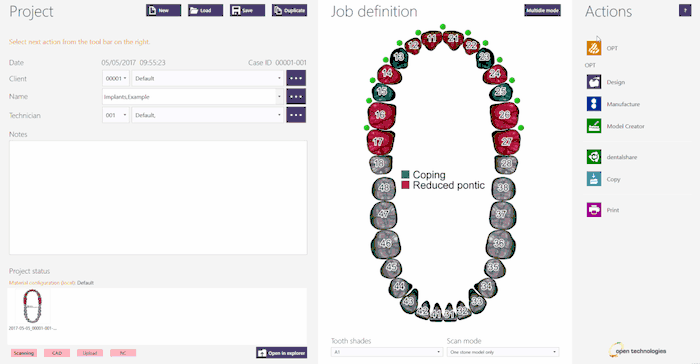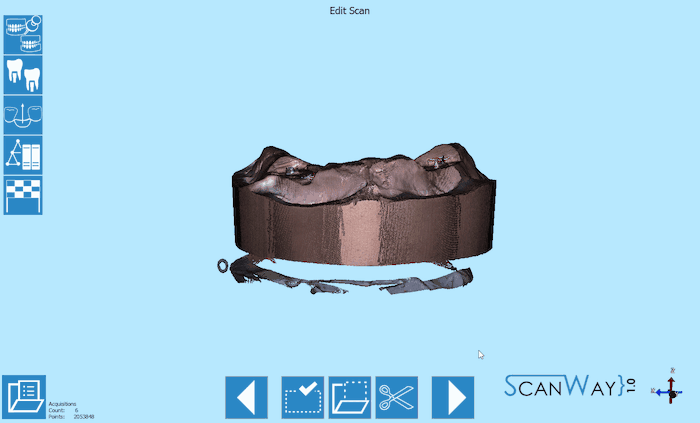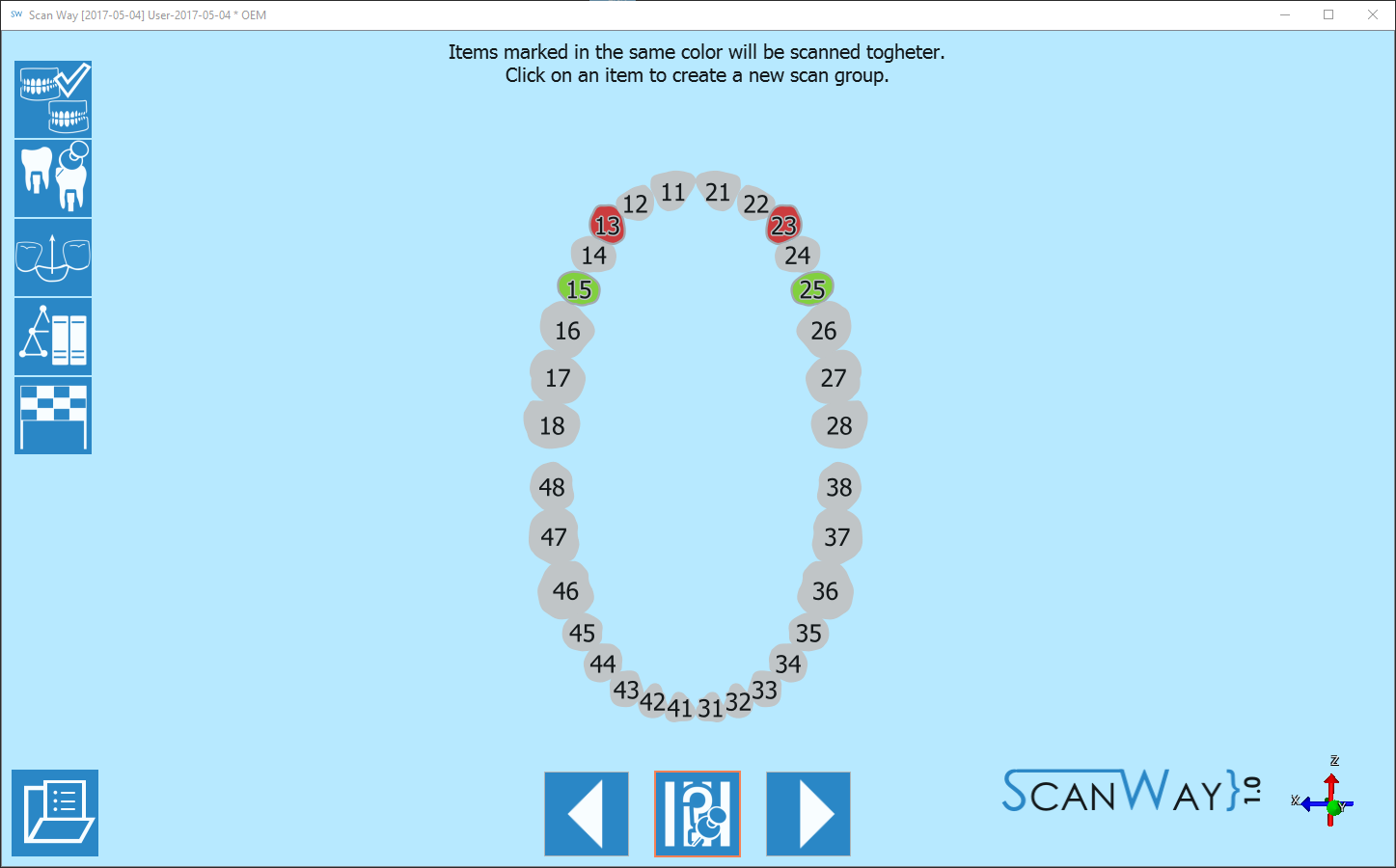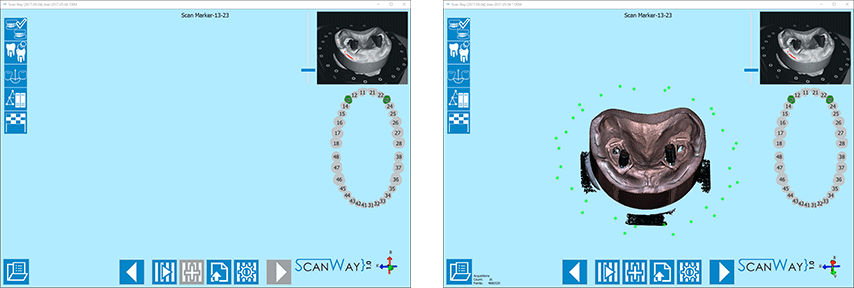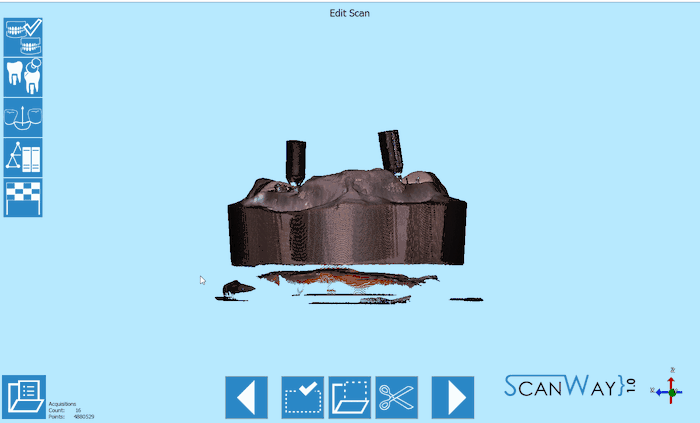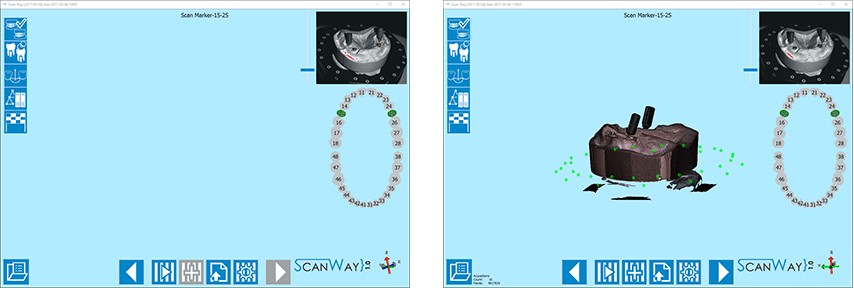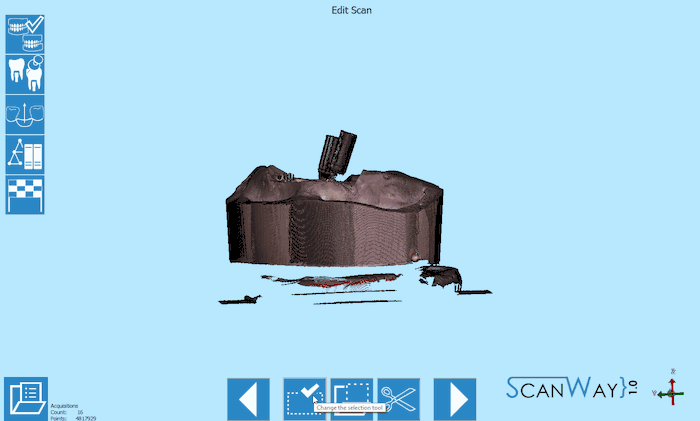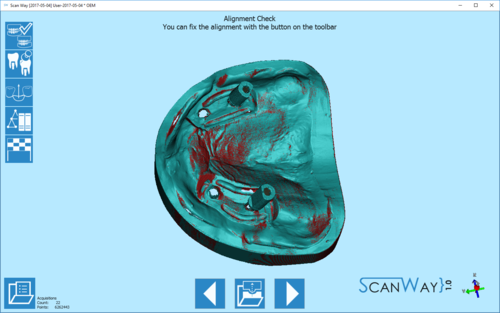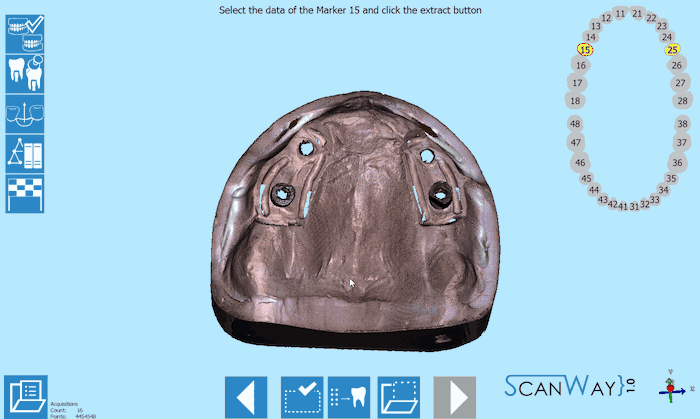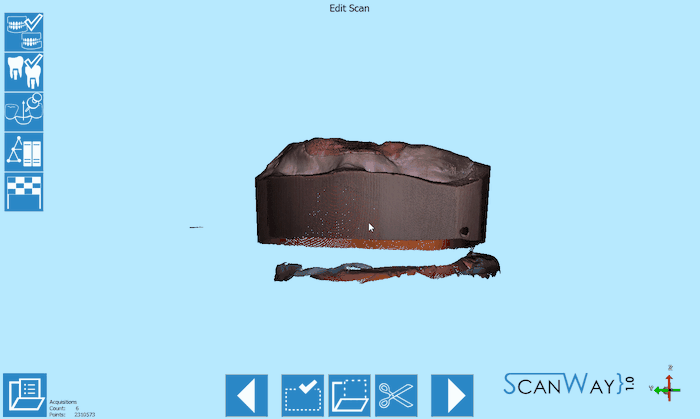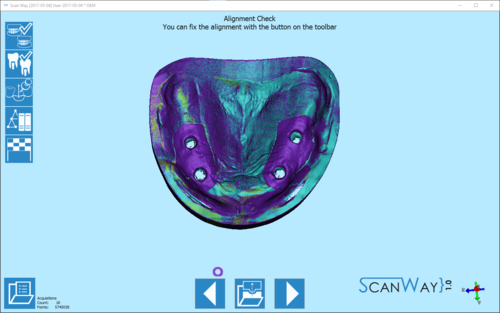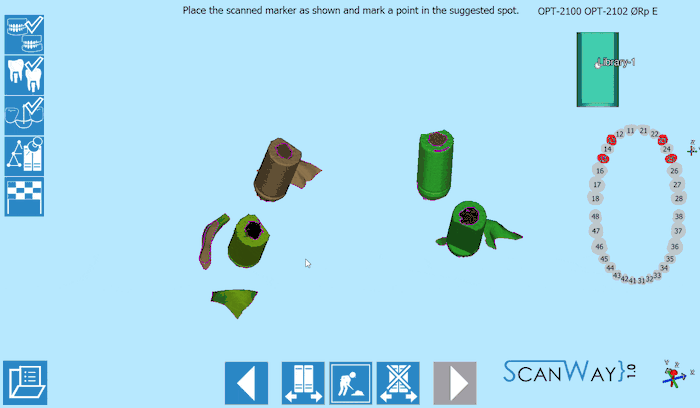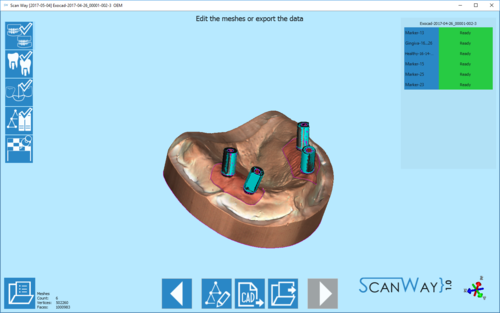Example: Implants
In questa pagina è mostrata e spiegata la procedura guidata da seguire per scansionare 1 modello con 4 impianti e parti di gengiva in silicone.
Per creare questo progetto in Exocad, cliccare sull'icona DentalDB sul desktop, aprendo così il Gestore Progetti.
Inserire le informazioni del progetto, il tipo di ricostruzione che dovrà essere modellata e i parametri aggiuntivi. Per questo tipo di progetto assicurarsi di selezionare Tipologia Impianti e Gengiva separata.
Per maggiori informazioni su come creare progetti in Exocad, visitare la pagina Exocad Wiki!
Di seguito la definizione di un progetto esempio:
Una volta che il progetto è stato definito è sufficiente cliccare su OPT nella sezione Azioni per avviare il software di scansione.
Il software mostrerà come prima cosa il progetto creato in Exocad. Se il progetto è corretto, cliccare il pulsante Accetta ![]() .
.
Contents
Definizione del progetto da ScanWay
Tutti i progetti possono essere definiti nel software di scansione stesso, indipendentemente dal tipo di CAD che verrà poi utilizzato per la modellazione.
Avviare il software facendo doppio click sull'icona ScanWay sul desktop. Si aprirà la Pagina di Benvenuto; per creare il progetto cliccare sulla prima icona.
Per informazioni più dettagliate su come definire un progetto, visitare la pagina: Creare un nuovo Progetto.
Di seguito la definizione del nostro progetto esempio:
Le definizioni di progetto sopra descritte portano entrambe ad avviare la medesima procedura guidata, che è composta dai passaggi seguenti.
Passaggio 1: Arcata Superiore
Dato che non c'è un modello in opposizione nel progetto qui definito, la prima scansione richiesta è quella dell'arcata superiore, che sarà il riferimento per il posizionamento di tutte le altre scansioni.
Questo passaggio prevede due sotto-passaggi.
Scansione
Posizionare il modello superiore sul piattello e cliccare il Pulsante Scansiona![]() .
.
IN QUESTA FASE E' RICHIESTO SOLO IL MODELLO IN GESSO. RICORDARSI DI TOGLIERE DAL MODELLO LA GENGIVA, I MARKER E OGNI ALTRO ACCESSORIO
I risultati dell'acquisizione verranno mostrati sullo schermo.
Cliccare ![]() per poter modificare i risultati ottenuti sul modello superiore.
per poter modificare i risultati ottenuti sul modello superiore.
Modifica
Questo passaggio permette di modificare l'immagine acquisita; per ulteriori informazioni sulle opzioni disponibili in questo passaggio consultare la pagina Strumenti di Modifica.
L'immagine a questo punto può essere modificata o ritagliata. A questo passaggio è fondamentale non modificare troppo l'immagine o non ritagliare considerevoli quantità di dati, questo perché il software ha successivamente bisogno di questi dati per effettuare l'allineamento automatico dell'oggetto con il suo riferimento.
Qui sotto un esempio di come ritagliare l'immagine usando lo strumento taglia base e rimuovere le parti da eliminare con un semplice doppio click.
Una volta soddisfatti del risultato, cliccare ![]() per accedere al passaggio seguente.
per accedere al passaggio seguente.
Passaggio 2: Marker
In questo passaggio l'utente deve acquisire i marker o scanbodies che verranno utilizzati come punti di riferimento per il corretto posizionamento della geometria e del canale della vite dell'impianto nel software CAD.
La scansione dei marker richiede diverse fasi.
Definizione
Non è necessario avere un marker per ogni impianto del modello, dato che i marker possono essere acquisiti a gruppi. Per meglio mostrare questa possibilità, i 4 marker da scansionare per questo progetto sono stati divisi in due gruppi di scansione, così come potete vedere:
Cliccare ![]() per scansionare il primo gruppo.
per scansionare il primo gruppo.
Primo Gruppo
- Scansione
- A seconda del numero di gruppi di scansione creati, il software proporrà una o più fasi di scansione.
Per prima cosa, all'utente verrà richiesto di inserire i marker avvitati sul modello nello scanner e acquisire gli elementi del primo gruppo.
Come promemoria, il software segnalerà nella parte destra della finestra gli elementi che devono essere scansionati insieme, al di sotto della vista live.
Posizionare il modello con i marker selezionati sul piattello e cliccare il Pulsante Scansione'![]() . I risultati verranno mostrati sullo schermo.
. I risultati verranno mostrati sullo schermo.
Cliccare ![]() per passare alla fase di modifica.
per passare alla fase di modifica.
- Modifica
- In questa fase è possibile pulire o ritagliare l'immagine. In questo caso è stato utilizzato lo strumento Selezione Rettangolare e l'azione Taglia è stata attivata nel menu contestuale.
Cliccare ![]() per passare alla fase di allineamento.
per passare alla fase di allineamento.
- Alignment
- The alignment for all scanned items is always automatic and it shows its results after the editing step.
To learn more on the automatic alignment and the manual procedure visit our Alignment Interface page.
- Marker Identification
- When a scan group has more than one item, the user will be asked to separate each marker from the others to correctly identify it.
To learn more on the identification of the dies visit the Scan Interface page.
Second group
- Scan
- Since in the project the markers have been divided into two groups, this is the last scan of the marker acquisition step.
As before, the software shows a reminder and marks the items to be scanned together on the right of the window, under the live view.
Place the model with the selected markers on the model holder and click the Scan Button![]() . Once the scan is finished the result will be shown.
. Once the scan is finished the result will be shown.
Click ![]() to access the edit step.
to access the edit step.
- Edit
- This image has been edited with the polygonal selection tool; the cut action has been activated in the contextual menu.
Click ![]() to access the alingment step.
to access the alingment step.
- Alignment
- The alignment for all scanned items is always automatic and it shows its results after the editing step.
To learn more on the automatic alignment and the manual procedure visit our Alignment Interface page.
- Marker Identification
- When a scan group has more than one item, the user will be asked to separate each marker from the others to correctly identify it.
To learn more on the identification of the dies visit the Scan Interface page.
Step 3: Gingiva
If in the project has been specified the presence of a silicon gingiva, that can be separated from the model, the software will ask the user to scan it on top of the reference model.
Also this step develops in different phases.
Scan Step
Place the upper model with the gingiva on the model holder and click the Scan Button![]() .
.
Once the scan is finished the result will be shown.
Edit Step
This item has been trimmed using the rectangular selection tool; the selected part has been deleted by pushing the DELETE (DEL) button on the keybord.
Automatic Alignment
As for the other items, the image of the gingiva aligns automatically to its reference (the upper model). The model part that matches the reference will then be removed automatically to keep only the actual gingiva part in mesh format.
Step 4: Healthy and Pontics
At this stage the project has been scanned, unless the user wants to rescan the healthy and pontics. In this case, since there are no healthy teeth there is no need to rescan.
Click ![]() to continue.
to continue.
The software will then propose a further edit step to allow the user to modify the healthy image. Proceed in the edit step as previously explained.
Step 5: Marker Alignment
To serve their purpose, the markers need to be aligned to an implant library: a virtual, geometric, accurate representation of the scanbody that has been screwed to the stone analog to mark its position.
The alingment to the library can be perfomed either in the scanning software or in Exocad. Since the market of libraries and scanbodies is so diverse, it is possible that some libraries will not work in our system.
Here below the library selection performed for our demo case:
Immediately after, the user will be asked to align the STL of the Marker to the scanned items:
To learn more on how to select a library and align the scanbodies to it, visit the section Marker alignment of the page Alignment Interface.
Step 6: Mesh Generation and Export
At this point the software immediately starts mesh generation. The meshes can be edited and exported individually or as a unique image. To learn more about mesh editing visit our Mesh Tools page.
Click on the Export Button ![]() to export to CAD.
to export to CAD.
If the project has been started from Exocad, the CAD will automatically open and the design can be started immediately. Otherwise the software will ask the user how to export the file.

